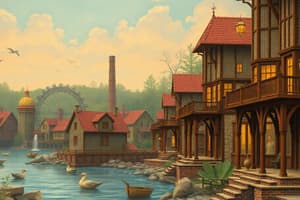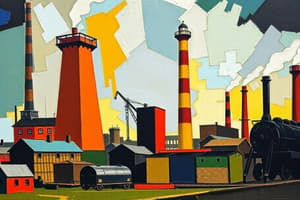Podcast
Questions and Answers
What does the Gilded Age refer to?
What does the Gilded Age refer to?
- The period of the Industrial Revolution
- The era of rapid economic growth (correct)
- The era of the American Civil War
- The age of exploration
What were the driving forces behind the Industrial Revolution in the United States?
What were the driving forces behind the Industrial Revolution in the United States?
Technology and an abundance of natural resources
What was the Industrial Revolution?
What was the Industrial Revolution?
A period of major changes in agriculture, manufacturing, mining, transportation, and technology
What are examples of natural resources used during the Industrial Revolution?
What are examples of natural resources used during the Industrial Revolution?
What is the significance of the Bessemer process?
What is the significance of the Bessemer process?
Coal was the main source of primary energy for industry and transportation in the West until the 1950s.
Coal was the main source of primary energy for industry and transportation in the West until the 1950s.
Who is credited with inventing the first practical telephone?
Who is credited with inventing the first practical telephone?
What term describes a style of capitalism with no government interference?
What term describes a style of capitalism with no government interference?
Who was a key industrialist and philanthropist during the Gilded Age?
Who was a key industrialist and philanthropist during the Gilded Age?
What does conspicuous consumption mean?
What does conspicuous consumption mean?
What is the definition of philanthropy?
What is the definition of philanthropy?
Urbanization was a result of the Industrial Revolution.
Urbanization was a result of the Industrial Revolution.
Flashcards are hidden until you start studying
Study Notes
The Gilded Age
- Refers to the late 19th century, characterized by rapid economic and population growth in the United States following the Civil War.
- Notable elements include technology, big business, urbanization, and immigration.
Technology Segment
- Technology and an abundance of natural resources fueled the U.S. Industrial Revolution.
- Natural resources vital to industrial growth included iron, coal, and oil.
Industrial Revolution
- A transformative period from the 18th to 19th century that reshaped agriculture, manufacturing, mining, transportation, and technology.
- Led to significant social, economic, and cultural changes.
Use of Natural Resources
- Iron: Processed through the Bessemer process, it became steel used in construction and manufacturing.
- Coal: Served as a primary energy source for industry and transportation from the 18th century to the mid-20th century.
- Oil: Gained strategic importance during World War I for fueling military equipment, exemplified by British Forces capturing Baghdad in 1917.
Transcontinental Railroad
- A railroad connecting the east and west coasts of the United States.
Inventors and Their Inventions
- Samuel F.B. Morse: Developed the telegraph, enabling wire signal transmission.
- Henry Bessemer: Innovated a mass-production process for steel, crucial for skyscraper construction.
- Alexander Graham Bell: Credited with inventing the first practical telephone.
Big Business Segment
- Laissez-faire capitalism dominated early industrial growth, encouraging unregulated money-making and the advent of Big Business.
Laissez-Faire Capitalism
- A form of capitalism where government interference in the economy is minimal or absent.
Forms of Business Organization
- Types include monopolies, conglomerates, pools, trusts, and holding companies.
Entrepreneurs (Robber Barons or Captains of Industry?)
- Andrew Carnegie: Industrialist known for philanthropy, especially in education and libraries.
- John D. Rockefeller: Revolutionized the petroleum industry; modern philanthropy pioneer.
- J. Pierpont Morgan: Key financier and banker who facilitated corporate mergers, notable for forming General Electric.
- Jay Gould: Financier known for his control of the Erie Canal and involvement in the 1869 gold market panic.
- Henry Ford: Innovated mass production techniques in the automobile industry.
Conspicuous Consumption
- Describes spending on luxury goods and services to display wealth, serving as a means of social status attainment.
Philanthropy
- The act of promoting the welfare of others through charitable donations and support of good causes.
Urbanization Segment
- Resulted from the Industrial Revolution, leading to the concentration of factories in cities, which became central hubs for resources and labor.
Studying That Suits You
Use AI to generate personalized quizzes and flashcards to suit your learning preferences.




